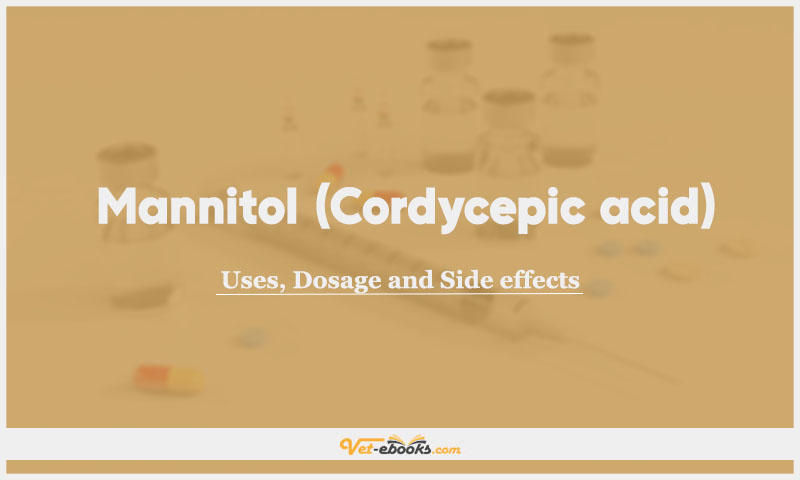Mannitol (Cordycepic acid) In Dogs & Cats: Uses, Dosage and Side Effects

Overview
- Mannitol is an inert sugar alcohol that acts as an osmotic diuretic.
Uses of Mannitol (Cordycepic acid)
• Reduction of intracranial pressure (ICP) (most effective in acute increases).
• Treatment of acute glaucoma.
• May also be used in the treatment of oliguric renal failure.
Dose of Mannitol (Cordycepic acid) in Dogs and Cats
Dogs, Cats:
Raised intracranial pressure:
- 0.25–2 g/kg i.v. infusion of 15–20% solution.
- Doses of 0.25–1.0 g/kg are recommended.
- The dose is given over 20–30 min.
- The dose may be repeated once or twice after 4–8 hours as long as hydration and electrolyte levels are monitored.
Acute glaucoma (if refractory to topical treatments):
- 0.5–2 g/kg i.v. infusion over 30 min.
- Withholding water for the first few hours after administering is recommended.
- May repeat 2–4 times over the next 48 hours; monitor for dehydration.
Early oliguric or anuric renal failure (as an alternative to using furosemide):
- 0.25–0.5 g/kg i.v. infusion over 5–10 min.
- If successful can repeat in 4 hours.
- Rehydrate the patient prior to the use of mannitol.
Drug Dosage Calculator
You Should Give:
Side Effects of Mannitol (Cordycepic acid) in Dogs and Cats
- Fluid and electrolyte imbalances.
- Infusion of high doses may result in circulatory overload and acidosis.
- Thrombophlebitis may occur and extravasation of the solution may cause oedema and skin necrosis.
- Mannitol causes diarrhoea if given orally.
- Rarely mannitol may cause acute renal failure in human patients.
Contraindications of Mannitol (Cordycepic acid) in Dogs and Cats
- Severe dehydration.
- Severe pulmonary congestion.
- Pulmonary oedema.
- Mannitol is labelled ”Use with care” in intracranial haemorrhage (except during intracranial surgery), but there appears to be little evidence to support this and it is used commonly in humans with traumatic brain injury and cerebral bleeds.
- There is some evidence for accumulation of mannitol where there has been a breakdown of the blood-brain barrier and this may cause rebound increases in ICP following
administration or raised ICP with prolonged therapy.
Some Notes:
- Diuretic-induced hypokalaemia may occur when used with potassium-depleting diuretics.
- Concurrent use of potassium-depleting diuretics should be used with care in conjunction with beta-blockers.
- Nephrotoxicity has been described with concurrent use of mannitol and ciclosporin in human patients.
- Mannitol may result in temporary impairment of the blood–brain barrier for up to 30 minutes after administration of high doses.
- Mannitol should never be added to whole blood for transfusion or given through the same set by which the blood is being infused.
- Do not add KCl or NaCl to concentrated mannitol solutions (20% or 25%) as a precipitate may form.
Tip
Do You Want To Increase Your Veterinary Knowledge and Practical Skills?
You Can Now Browse and Download +3000 Books For Veterinary Professionals & Students Online.
Download Veterinary Books




















